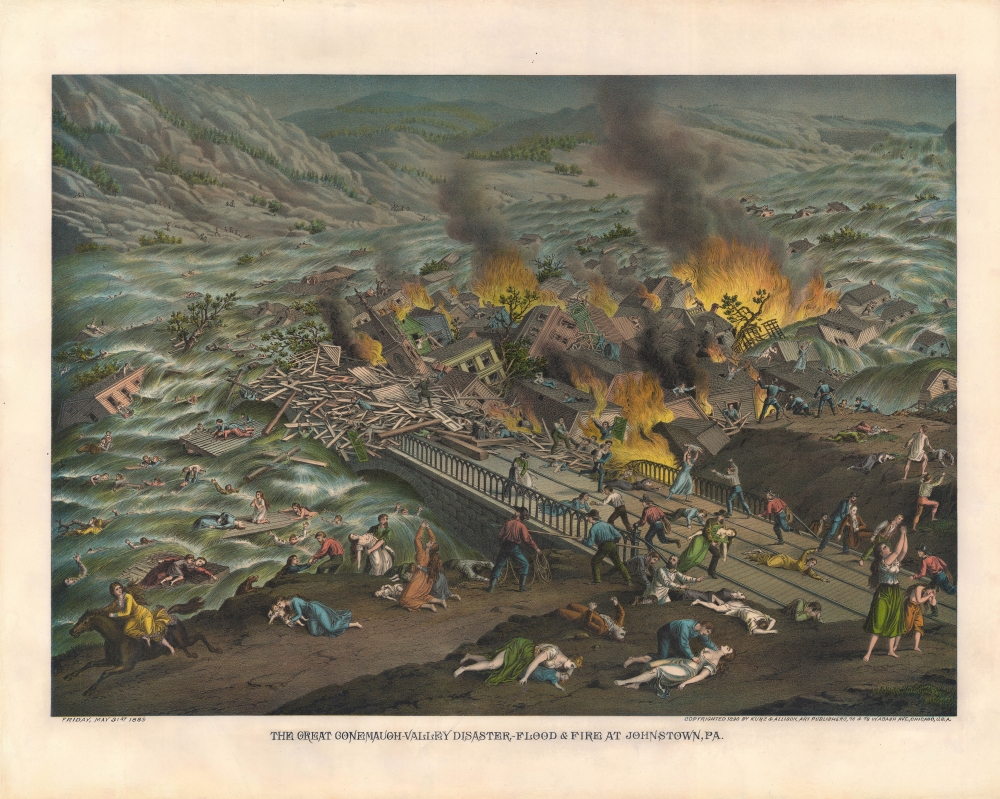This item has been sold, but you can get on the Waitlist to be notified if another example becomes available, or purchase a digital scan.
1889 Kurz and Allison View of the Johnstown Flood, Pennsylvania
JohnstonFlood-kruzallison-1889
Title
1889 (dated) 21 x 27 in (53.34 x 68.58 cm)
Description
The Johnstown Flood
The Johnstown Flood was a catastrophic flood of the Conemaugh River that devastated Johnstown, Pennsylvania, on May 31, 1889. The flood followed a storm that formed in the Midwest and swept across the country. When it arrived in Johnstown, it dropped from six to ten inches of torrential rain in just 24 hours - the most rain that region had ever seen. As streams and rivers swelled with runoff, the Conemaugh River overran its banks.To make matters worse, the South Fork Dam, some fourteen miles upstream, burst, adding all the waters from the three-mile long Lake Conemaugh to the Little Conemaugh River. The water surged towards Johnstown, increasingly choked with debris until it smashed into the 78-foot-high Johnstown Viaduct. The debris clogged the viaduct, creating a second, even larger dam. The viaduct was only able to hold back the water for a few moments before it too burst, sending the debris filled water towards helpless Johnstown. One witness described the event as 'a huge hill rolling over and over'.
The surging sixty-foot wall of water smashed into Johnstown at roughly forty miles per hour, utterly destroying the town. Much of the debris then came up against the Pennsylvania Railroad Stone Bridge across the Conemaugh River. The well-made bridge held back the flood in yet another temporary dam. There the debris caught fire, capturing many in an inferno. It is that moment that is depicted here. Shortly thereafter, the waters reversed, creating a second flood that struck Johnstown from the opposite direction, finalizing its destruction. The resultant fires lasted some three days and the debris, covering thirty acres, took months to clean. The death toll reached 2,208 people, marking it as one of the greatest natural disasters in U.S. history.
Chromolithography
Chromolithography, sometimes called oleography, is a color lithographic technique developed in the mid-19th century. The process involved using multiple lithographic stones, one for each color, to yield a rich composite effect. Oftentimes, the process would start with a black basecoat upon which subsequent colors were layered. Some chromolithographs used thirty or more separate lithographic stones to achieve the desired product. Chromolithograph color could also be effectively blended for even more dramatic results. The process became extremely popular in the late 19th and early 20th centuries when it emerged as the dominant method of color printing. The vivid color chromolithography produced made it exceptionally effective for advertising and propaganda imagery.Publication History and Census
This view was drawn and engraved by the firm of Kurz and Allison in Chicago. The print bears the date of May 31, 1889, but it was likely issued several months after the events. Poor cataloging makes it very difficult to perform a reasonable census on this map. It is rare to the market, we note only one sale, but is represented in perhaps a dozen libraries nationwide.Cartographer
Kurz and Allison (1880 - c. 1905) was an American publishing firm known for its chromolithographs. Founded by Louis Kurz (1835 - 1921) and Alexander Allison, the firm was based at 267-269 Wabash Avenue in Chicago. In the partnership, it is known that Kurz, an Austrian immigrant, was the lithographer and it is presumed that Allison provided the financial backing. The firm is most well-known for its series of thirty-six battle scenes from the American Civil War. At the time of their publication, the late 1880s and early 1890s, a general nostalgia was prevalent among Civil War veterans (of which Kurz was one), and evidently the company was trying to capitalize on the sentiment. Kurz and Allison's Civil War prints were not the first such prints to be issued, but they were by far the most popular. In a style reminiscent of Currier and Ives, Kurz and Allison lithographs are not meant to be historical representations, and even, from time to time, included historical inaccuracies. Even so, 'prints depicting the Civil War battles by Kurz and Allison are among the most sought-after collectibles of Civil War enthusiasts.' Their prints are also notable for featuring African-American soldiers, a rarity for the era. After the outbreak of the Spanish-American War, the firm published views from famous battles and continued doing so for the campaigns of the Philippine-American War and the Russo-Japanese War. More by this mapmaker...

